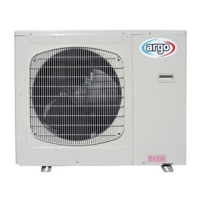11
4. Air Purging
Air and moisture remaining in the refrigerant system
have undesirable effects as indicated below. There-
fore, they must be purged completely.
● pressure in the system rises
● operating current rises
● cooling efficiency drops
● moisture in the air may freeze and block capillary
tubing
● water may lead to corrosion of parts in the refriger-
ant system
■
Air Purging with a Vacuum Pump
(for Test Run)
● In order to protect the earth’s environment, be sure to
use a vacuum pump to perform the air purge.
(Never perform an air purge by using the refrigerant
gas cylinder or other external gas, or by using the gas
inside the outdoor unit.)
Perform the air purge for tubes A, B, C, and D. Use the
same procedures for all tubes.
(1) Check that each tube (both narrow and wide
tubes) between the indoor and outdoor units have
been properly connected and all wiring for the test
run has been completed. Note that both narrow
and wide tube service valves on the outdoor unit
are kept closed at this stage.
(2) Using an adjustable wrench or box wrench,
remove the valve caps from the service valve on
both narrow and wide tubes.
(3) Connect a vacuum pump and a manifold valve
(with pressure gauges) to the service port on the
wide tube service valve. (Fig. 20).
valve open.
Be sure to use a manifold valve for
air purging. If it is not available,
use a stop valve for this purpose.
The “Hi” knob of the manifold
valve must always be kept closed.
Before using the vacuum pump
adapter, read the vacuum pump
adapter manual, and use the
adapter correctly.
In order to prevent charging errors with
A/C that uses R410A, the screw diameter
at the service valve charging port has
been changed. When recharging or per-
forming other servicing, use the special
charging hose and manifold gauge.
● When using a hex wrench to open the spindle, an
extremely small amount of refrigerant may leak.
This does not indicate a problem.
● Use a hex wrench of a type to which force can be
easily applied.

